June 24, 2024. It’s surprising how often a chance meeting will lead to a photo. In September 2023, while staying at a hotel in Ottawa, Ontario, we were approached by a fellow guest, Victor Richard, who had seen us coming out of our car the day before and had noticed the Prince Edward Island licence plate. The following day, when he saw us in the lobby, he explained that he was from New Brunswick, the province next to ours.
….The road to a soldier’s photo can be circuitous….
Victor showed an interest in the On The War Memorial Trail research project. Pieter asked for his help in finding a photo of a particular soldier, and after we all returned back home, Victor put us in contact with Jean Gaudet. In the meantime, Pieter had found a photo of the soldier online, as it had recently been posted on the Canadian Virtual War Memorial by Captain (Retired) Etienne L.L. Gaudet.
Jean knew Captain Gaudet well and very quickly Pieter was put in contact with Etienne, who works diligently in ‘…promoting the memory of soldiers in New Brunswick…’ – as Jean put it. During the Covid period, Etienne had visited 244 cemeteries, documenting the graves of soldiers across New Brunswick. (See https://www.cbc.ca/news/canada/new-brunswick/nb-veteran-journey-cemeteries-1.6237590)
After learning about the On The War Memorial Trail research project, Etienne emailed Pieter. “…God bless you for the work you are doing. I certainly share your passion in ensuring none of these heroes are ever forgotten. I have worked very hard to build the Canadian Virtual War Memorial especially for those soldiers buried in New Brunswick who lacked pictures on the site.
I am now the person responsible for Veterans in Memramcook, which involves organizing our Remembrance Day ceremony and all other things related to honouring those that have served from …Memramcook….”
Etienne ended by making an offer to help. “…Please don’t hesitate to write if I can assist you in any way…”

Pieter with Etienne Gaudet. (Photo credit: Daria Valkenburg)
….An offer to help led to a photo….
Pieter soon asked for Etienne’s assistance with a photo search, asking if he would be willing to contact the family of an Acadian soldier, Edgar M. GUITARD. “….He lost his life in The Netherlands on the 15th of January 1945. He had 6 brothers and 4 sisters. This morning I called the daughter of his youngest sister Emelia, Nicole Lagace, but she said that she had never heard of Nicole Lagace or Emelia Guitard. I have a feeling that she thought that I was a scammer and did not trust me….. Would you be able to help?….”
Pieter hoped that a French-speaking voice on the phone might reassure Nicole Lagace, but Etienne decided to pay a visit in person the following morning. That evening he reported back. “…I was able to speak with Nicole in person. She has a photo of Edgar in her albums, but didn’t have time today to go through them. She apologized for her reaction to your phone call and stated that she has been scammed before and is incredibly careful now….”
A few days later…success! Etienne reported that he’d “…received the photo from Nicole Guitard Lagace, who confirms that the gentleman in the photo is her uncle, Edgar M. Guitard.…I do hope his memory can live forever although he died way too young. It was an honour to assist you and help preserve his memory in perpetuity. We will remember them….”
Nicole also contacted Pieter, explaining that “…the photo donated by me belonged to my mom. Thank you very much….”
….Edgar was born in Belledune….
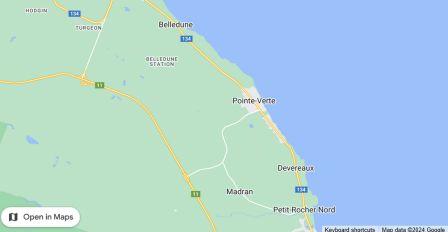
Map shows location of Belledune, New Brunswick, located on Chaleur Bay. (Map source: Google maps)
Edgar was born on September 17, 1917 in Belledune, New Brunswick, a port village on Chaleur Bay, the son of Jean ‘Mickey’ and Bridgitte Guitard. One of 11 children, Edgar grew up on his parents’ farm.
When he enlisted at District Depot No. 5 in Rimouski, Quebec on April 8, 1941, he stated that he had served in the Active Militia since January 1941 – with No. 71 Centre Militaire out of Edmundston, New Brunswick. He also stated that he was a fisherman during the spring and summer, and had worked as a lumberjack since 1930 for Fraser Brothers, out of Causapscal, Quebec. Edgar enjoyed snowshoeing and fishing.
His Soldiers Qualification Card noted that he was illiterate, due to not having attended school, and was French speaking.
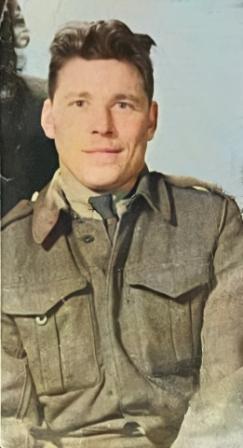
Edgar M. Guitard. (Photo courtesy of Nicole Lagace. Photo colourization by Pieter Valkenburg)
Based on his extensive experience as a lumberjack with Fraser Brothers, Edgar was transferred to No. 12 Company of the Canadian Forestry Corps (CFC) in Valcartier, Quebec on April 12, 1941.
Unlike other members of the Canadian Army, members of the Canadian Forestry Corps were not expected to be in combat. Their role was to help the British with their need for timber. As stated in an article on http://www.canadiansoldiers.com/corpsbranches/forestrycorps.htm “…wood was needed for living quarters, messes, and recreation facilities, as well as crates for vital supplies such as food, ammunition and even vehicles, and for the creation of explosives, stocks for weapons, the construction of ships, aircraft and factory facilities….”
Canada agreed to send workers and equipment to Great Britain, with the Corps Headquarters based in Scotland. The British designated the areas of work, and the final disposal of the lumber created, but all military operations were under the control of Canadian Military Headquarters in London, England.
Although the men serving in the Canadian Forestry Corps were not in a combat role, they were provided with very rudimentary basic training in using firearms, only because of the impending threat of German invasion.
….Edgar left Canada for overseas service….
After about 6 weeks of basic training, Edgar left Halifax, Nova Scotia for the United Kingdom on June 18, 1941, arriving in Gourock, Scotland on July 2, 1941. He remained with No. 12 Company until September 29, 1943, when he was transferred to No. 11 Company, and then on March 19, 1944 to No. 5 Company.
The work done by the Canadian Forestry Corps (CFC) included building barracks, roads, bridges, and setting up power plants. They also helped with snow clearance on the highland roads in Scotland. Each company of the CFC had two sections, one cutting in the bush and bringing out the timber, and the other sawing it into lumber at the company mill.
For an idea of the hard work done by the Corps, take a look at this very short British Pathé video Canadian Forestry Corps In Britain (1941)….
It was work that Edgar thrived at, but things were about to change. By the spring of 1943, a desperate need for more soldiers in the Canadian Army caused several hundred soldiers to be redeployed. Edgar was able to remain in the United Kingdom until after D-Day on June 6, 1944.
….Edgar was sent to France….
The above referenced Canadian Soldiers article explained that “…..after the landings in Normandy in June 1944, ten companies eventually moved to the Continent to continue operations there; 77 square timber rafts and 54 round timber rafts had been created in Southampton to move timber across the English Channel with them. By the end of August 1944, operations had commenced on the continent….”
No. 5 Company was one of these ten companies, now part of the 21st Army Group. On July 26, 1944, Edgar left for France with No. 5 Company, arriving a day later.
Edgar remained with the No. 5 Company until November 25, 1944, when he was transferred to the X-4 Reinforcement List of the 10th Battalion of the Canadian Infantry Corps. The lumberjack was now a soldier, even though his training had not prepared him for combat.
….Edgar’s transfer to Le Régiment de la Chaudière was his last….
On January 13, 1945, Edgar was transferred to Le Régiment de la Chaudière and allotted to ‘A’ Company. The Regiment had wintered in the Nijmegen Salient, while preparing for the upcoming fight in the Rhineland in February 1945. They were based on the Holthurnsche estate in The Netherlands, near the German border, between the cities of Berg en Dal and Nijmegen.
While on the estate, Edgar was one of two casualties hit by stray mortar fire. The Regiment’s War diary entry for January 14, 1945, written at 10:30 am…. “…La cie A: 2 casualties par l’action des mortiers allemands….” (English translation: ‘A’ Company: 2 casualties by the action of German mortars.) He died the following day, aged 27.
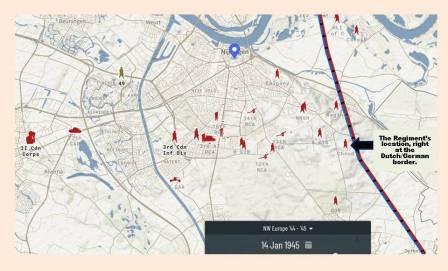
Location of Le Régiment de la Chaudière on January 14, 1945, near the Dutch/German border. (Map source: Project ’44)
Today the area where the Regiment overwintered is the Hotel Holthurnsche Hof.
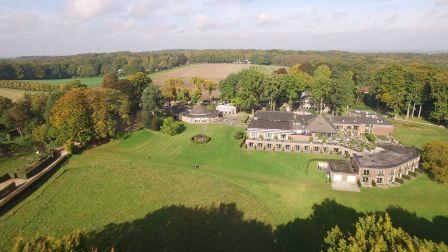
Hotel Holthurnsche Hof is now where Le Régiment de la Chaudière was located in mid-January 1945. (Photo source: http://realhealth.nl/hotel-holthurnsche-hof/)
..…Edgar is buried in Groesbeek …..
Edgar was initially buried in a temporary Canadian cemetery in Nijmegen on January 16, 1945, before being reburied in the Canadian War Cemetery in Groesbeek, The Netherlands on August 7, 1945.
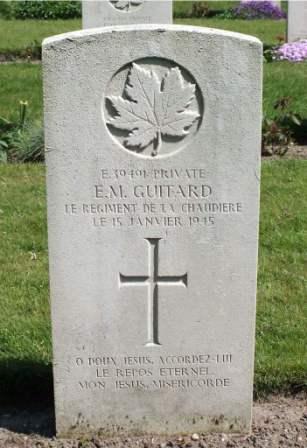
Grave of Edgar M. Guitard in the Canadian War Cemetery in Groesbeek, The Netherlands. (Photo source: Find A Grave)
Thank you to Etienne Gaudet for going above and beyond to meet a family member of Edgar Guitard, and to Nicole Lagace for submitting a photo of her uncle. Many thanks also to Victor Richard and Jean Gaudet for connecting the dots that led to us meeting Etienne! Do you have photos or information to share? Email Pieter at memorialtrail@gmail.com, comment on the blog, or tweet to @researchmemori1.
© Daria Valkenburg
….Want to follow our research?….
If you are reading this posting, but aren’t following our research, you are welcome to do so. Our blog address: https://onthewarmemorialtrail.com/
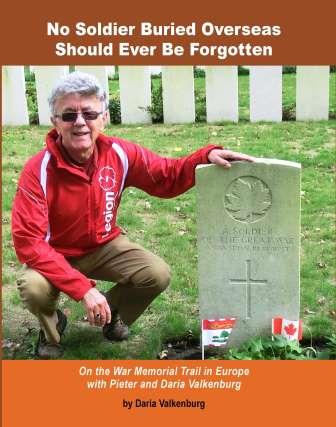 4 countries, 6 weeks, 7,000 km – an unforgettable war memorial journey in Europe…. Daria’s book ‘No Soldier Buried Overseas Should Ever Be Forgotten‘ is available in print and e-book formats. Net proceeds of book sales help support research costs and the cost of maintaining this blog. For more information see https://nosoldierforgotten.com/
4 countries, 6 weeks, 7,000 km – an unforgettable war memorial journey in Europe…. Daria’s book ‘No Soldier Buried Overseas Should Ever Be Forgotten‘ is available in print and e-book formats. Net proceeds of book sales help support research costs and the cost of maintaining this blog. For more information see https://nosoldierforgotten.com/
You are also invited to subscribe to our YouTube Channel: On The War Memorial Trail With Pieter Valkenburg: https://www.youtube.com/channel/UCJ591TyjSheOR-Cb_Gs_5Kw.
Never miss a posting! Subscribe below to have each new story from the war memorial trail delivered to your inbox.




